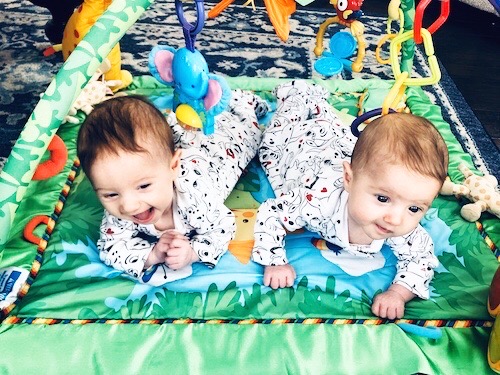Last updated on July 30th, 2024 at 04:01 pm
What exactly is Container Baby Syndrome? We’ll explain what it is, how it can affect your babies, and how to avoid it, especially with twins.
When new parents ask the question, “What will I need for my baby?”, there is a wide spectrum of answers and opinions. However, nearly all are filled with lots of “equipment” or “baby container” recommendations. Of course, you’ll need a car seat and stroller for safe transportation, oftentimes multiple strollers – a stroller for everyday use, an umbrella stroller for traveling, maybe a jogging stroller for exercising. You will hear from many parents that their newborns hated the crib and only slept in a swing or bouncer (FYI, please don’t do this — we now know inclined sleeping can be fatal). And once you’re out of the newborn phase, you’ll (of course) need an exersaucer and a jumperoo. Having twins? Double your order because certainly, they won’t be happy taking turns! But perhaps these recommendations aren’t what’s actually best for your baby.
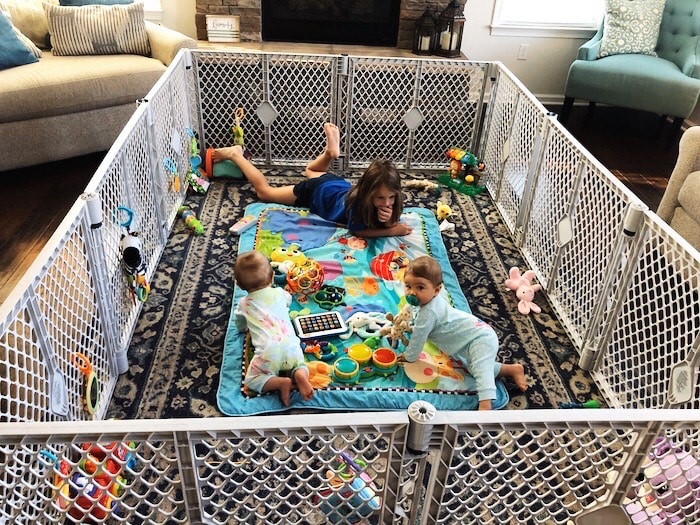
What is Container Baby Syndrome?
While all of this equipment is colorful and fancy, it is causing a new problem at epidemic rates – Container Baby Syndrome. Container Baby Syndrome refers to a range of conditions caused by an infant spending too much time in “containers”, such as bouncers, swings, and other positioners that don’t allow a range of motion. These conditions include gross motor delays, cognitive delays, social interaction problems, and even skeletal deformities.
Baby containers were designed for a variety of purposes and most function to keep baby safe, allow parents to easily transport their baby, and to give baby playtime in a position the baby may not be able to independently get into. However, these containers actually limit free movement and keep babies from moving their bodies in a developmentally normal way.
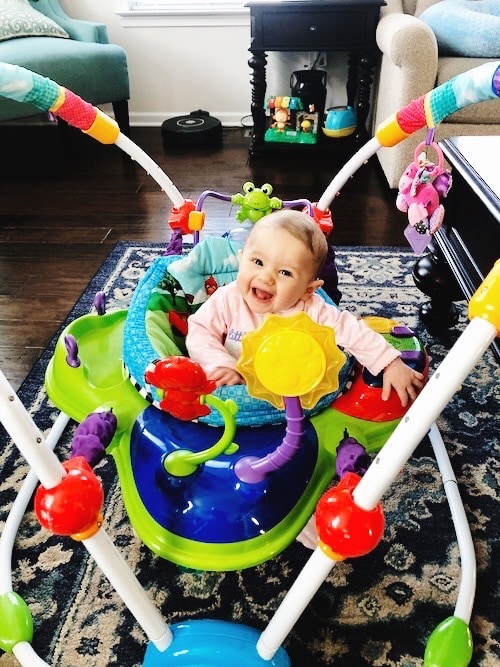
Why Is Container Baby Syndrome So Prevalent Now?
Research suggests that the prevalence of Container Baby Syndrome increased 600% from 1992 to 2008. Why? It is likely related to the Back to Sleep program of 1992. The Back to Sleep program was created to reduce the incidence of SIDS (Sudden Infant Death Syndrome), and it has been very successful. We encourage you to continue sleeping your babies on their backs. (Click here for more information on SIDS)
However, subsequent issues have emerged, most as a result of infants not receiving enough tummy time. Parents are often afraid to position young infants on their tummies and are instead choosing equipment (i.e. swings, bouncers, vibrating chairs, etc) to hold their babies when they can’t. This has resulted in epidemic rates of Container Baby Syndrome. Because babies are not experiencing free movement during floor play and tummy time, the following may result:
- Torticollis (tightness in one side of the neck)
- Plagiocephaly (asymmetrical flattening of the skull)
- Delayed motor skills including rolling, crawling, and walking
- Decreased strength and coordination
- Delayed visual and cognitive skills
- Increased weight/obesity
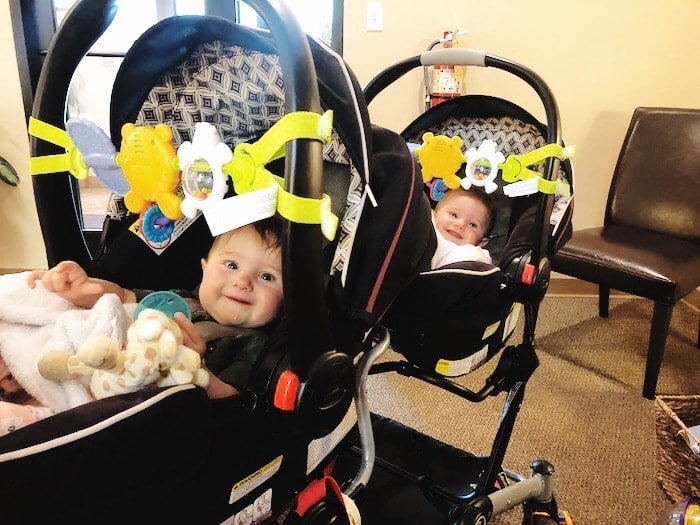
Not all use of equipment is bad or damaging to your baby. Container Baby Syndrome doesn’t develop overnight; it’s the result of chronic overuse of containers. Here are some guidelines to know if your baby is spending excessive time in containers:
Container Baby Syndrome Red Flags for a 5-Month-Old Baby
- Observed abnormal head shape
- Limited neck range of motion and/or holding head to one side consistently
- Baby would rather stand than sit (baby may stiffen legs, making it hard for you to bend them)
- Intolerance for floor play/exploration including tummy time
- Making no attempts to roll over
- Not kicking feet/legs when on their back
- Not reaching for and exploring toys with their hands
- Constantly “fussy” when not in a container
The good news? Container Baby Syndrome is 100% preventable by using containers only when necessary and on a limited basis. Here are some guidelines on the prevention of Container Baby Syndrome.
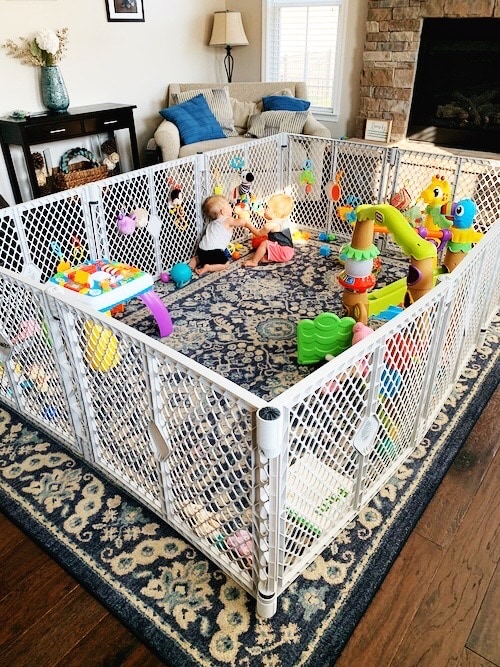
Guidelines on the Prevention of Container Baby Syndrome
- Save your money and use the floor! Create a safe floor space for baby during the day.
- Limit container use to only when the baby is actually being transported somewhere or absolutely needs to be secured in a safe place
- Increase tummy time when awake – the more the better; it’s all about frequency!
- Babywearing – even though overall movement is limited, infant carriers and slings leave baby’s head and neck free to move and take the pressure off the back of the skull
If you are concerned that your baby may have Container Baby Syndrome, discuss it with your pediatrician. Early Intervention services are available to help. Physical therapy treatment has shown to build strength, restore movement, and address skeletal deformities for infants diagnosed with Container Baby Syndrome.
Twiniversity Note: As parents of twins, it is extra challenging to avoid Container Baby Syndrome. Just the fact that we carried twins means they are already more prone to conditions like torticollis and plagiocephaly based on their tight positioning in utero. On top of that, you may be chasing extra kids (and pets!) around, which makes it very difficult to keep your babies on the floor. Do NOT feel guilty about using “baby containers” but try your best to limit how much you use them. The best thing you can do is change it up throughout the day. If your twins have been sitting in their bouncers for 20-30 minutes already, get them out and into something else — their cribs, the floor, any place that’s safe where they can lie flat on their backs or their bellies with a full range of motion. This was a HUGE challenge for me at first when my twins were diagnosed with torticollis and I felt super guilty putting them in containers when I sometimes had no other choice. However, I eventually found a good balance and realized there’s only so much I could do. I invested in a super play yard (buy on Amazon) which made a huge difference. Do the best you can and just know that your babies may need physical therapy anyway, regardless of how much tummy time you’re giving them. You are not alone!!! – Julie, the Twiniversity Wizard.

Stacey Haught is a mom to 7 year old Madison, 6 year old twin boys – Mason and Mitchell, and 18 month old twin girls – Sadie and Sophia. She is a pediatric physical therapist but has put her career on hold to stay at home with her rambunctious 5 kids. She resides with her husband and kids just outside of Pittsburgh, PA. Her family enjoys everything outdoors regardless of the season – finding new sledding hills, exploring area parks, and hiking and camping at their family cabin.

